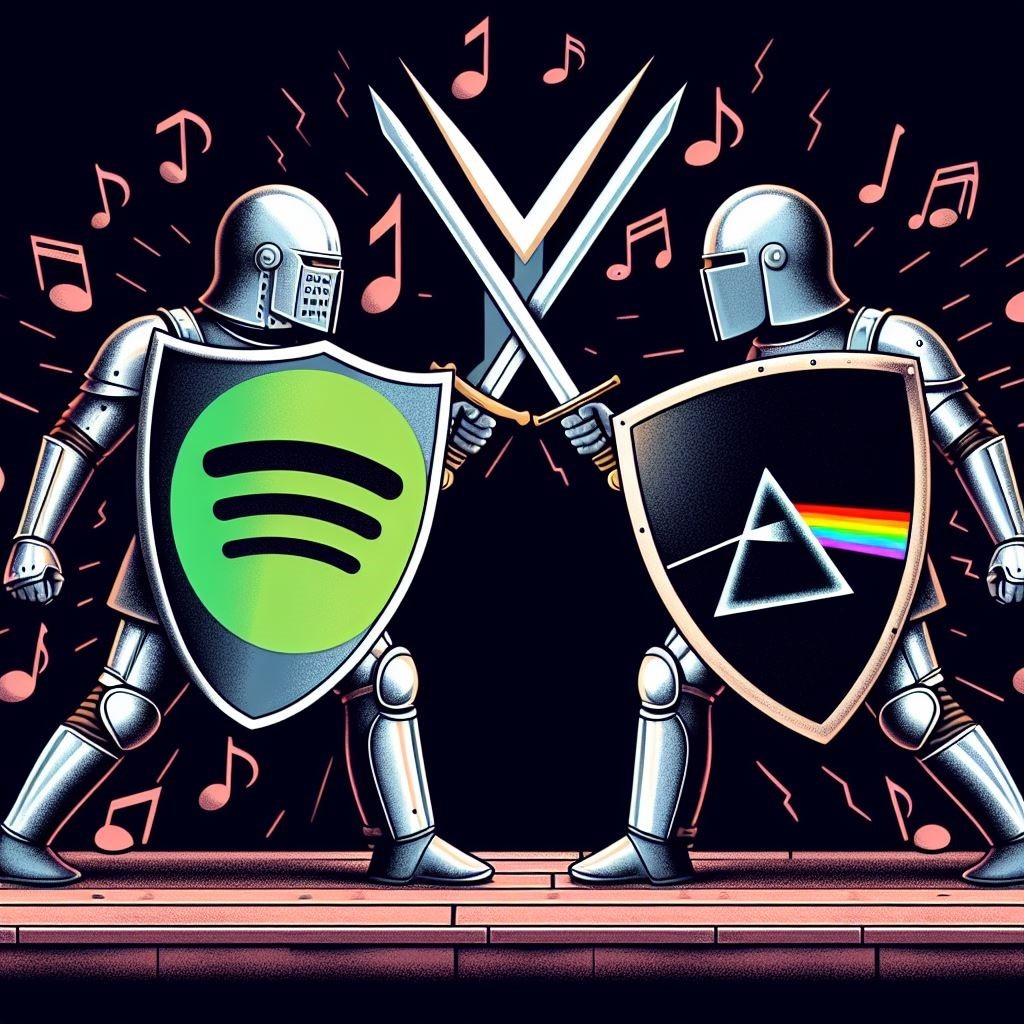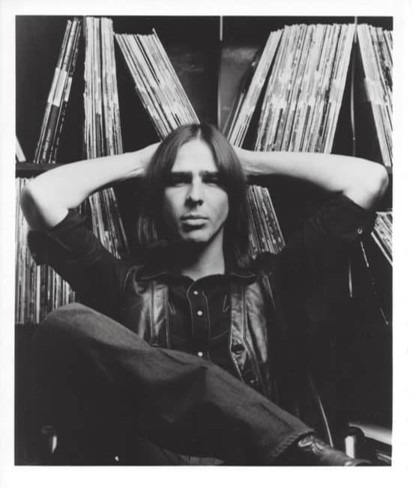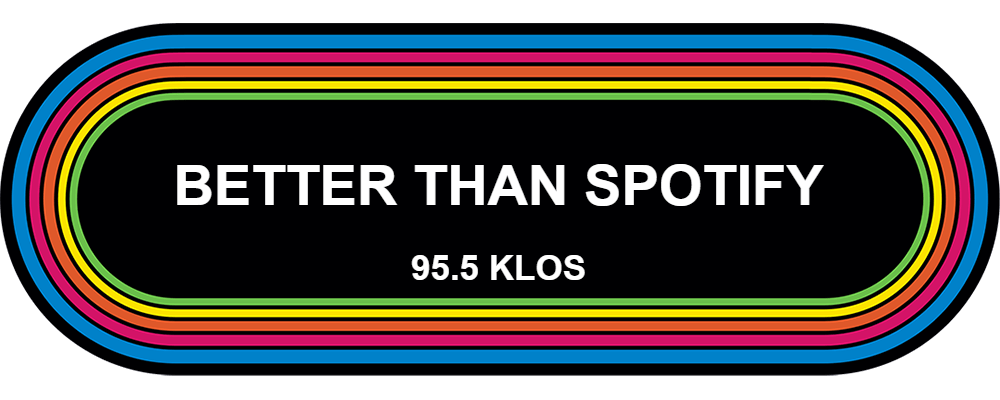
For a brand that’s been around for 18 years now, Spotify has truly pulled off some remarkable feats. While not “first in,” the Swedish music streaming behemoth has become the most popular music streaming platform, passing Pandora, Slacker, and other brands that have fallen by the wayside.
And in an effort to diversify its business model, Spotify has made a run at trying to own podcasts, bolstered by their highly publicized signing of the most popular podcaster on the planet, Joe Rogan. And in no short order, they’ve all but vanquished the former leader, Pandora, as well as other digital streaming platforms in its wake.
to own podcasts, bolstered by their highly publicized signing of the most popular podcaster on the planet, Joe Rogan. And in no short order, they’ve all but vanquished the former leader, Pandora, as well as other digital streaming platforms in its wake.
It hasn’t been a particularly easy road for Spotify in spite of their dominance. Their inability to turn a profit is a nagging problem, exacerbated by their core business – music streaming – incurring onerous royalty fees.
And Spotify’s attempt to diversify its portfolio with more profitable pursuits – such as podcasting – hasn’t generated enough revenue to offset its streaming music costs.
A story in New York’s “Intelligencer” last fall by John Herrman featured a blaring, evocative title:
“Spotify is Eating the Entire Music Business”
It’s a lengthy piece cataloging Spotify’s outsized influence among labels, artists, and pretty much all facets of the music machine. Herrman catalogs Spotify’s growing dominance in the music business, now branching out with Merch Hug, another sub-business designed to help bands (and Spotify) sell shirts, hats, posters, and the other items that remind us and our friends about our favorite bands and the concerts we’ve seen.
B ut in spite of Spotify’s rapid growth, Herrman points out Spotify’s ugly truth:
ut in spite of Spotify’s rapid growth, Herrman points out Spotify’s ugly truth:
In 2022, while streaming now makes up nearly 90% of music revenues, the largest music streaming service cannot turn a profit. As Herrman points out, Spotify now has nearly a half billion global users, and 200 million of them are subscribers.
And despite that, Spotify’s red ink totaled a whopping loss of $430 million euros. Along the way, Spotify has instituted prices increases, while also laying off 2,300 employees last year – a sizable percentage of its total workforce.
In many ways, Spotify has flipped the music model, and many artists have been vocal about – in their perception – low payouts for streams. It used to be physical music sales was the dominant profit center. Artists could bolster music sales by touring and merch sales.
Today, music streaming is the promotional glue that supports concert tours and revenue from the sale of merch. But few are getting rich from their streams. For many artists – especially the older ones – touring takes a physical, financial, and emotional toll. But that’s how musicians are forced to sustain themselves in 2024.
As Hermann points out, Spotify’s strategy is to dominate every aspect of the music revenue model. That means encroaching on every piece of turf it can. And it also means squeezing out competitors like Bandcamp and anyone else who stands in its way. Spotify may be a Swedish company, but it emulates American capitalism to a T.
In the process of trying to dominate the music business, Spotify is attempting to do a number on radio – trying to steal its listeners, especially the young ones, featuring user-generated playlists, access to its massive on-demand library, and offering an experience without radio’s excesses – all that talk and all those commercials.
Seems foolproof. Except when it’s not.

This reality hit home for me when a half dozen of you sent me an essay that appeared in the New York Times’ Magazine over the weekend. Written by thirtysomething journalist, Nate Rogers, he had me with the headline and the subtitle:
The Retro Music Genre That Will Change Your Life
Classic rock rules. When the right song comes on the radio, I pretty much see God.
Of course, the genre Nate is referring to is Classic Rock, and his station of choice is KLOS in his city of residence, Los Angeles. And like so many others, he also is a Spotify user.
His fascinating comparison of these two brands boils down to this: Spotify’s Autoplay function is inherently passive, remaining inoffensive and in the background. Rarely does it include music with grit or edge, the essence of great Classic Rock.
And then there’s KLOS. They’ve been around for more than a half century in the same format, featuring iconic morning shows and other strong personalities throughout the day, and always reflecting the SoCal vibe. For Nate, KLOS is a very foreground brand, the perfect soundtrack for  cruising around L.A., especially breezing by musical landmarks like the Whiskey, the Morrison Hotel, and Laurel Canyon.
cruising around L.A., especially breezing by musical landmarks like the Whiskey, the Morrison Hotel, and Laurel Canyon.
As Nate notes, “I like listening to rock ‘n’ roll not to accent my world but rather to draw my active attention.”
And that’s what a radio station with personality and a pulse delivers. Whether it’s ’80s Hair Bands, vintage Hendrix, KISS anthems, or Metallica growling, KLOS serves it up – often unexpectedly. And that’s the charm of radio, the anti-algorithm music delivery platform that surprises, delights, but also pisses you off.
That’s because there’s something else about radio that sets it apart from a DSP like Spotify – you end up hearing music you despise. Nate may have a love/hate relationship with some songs (OK, maybe mostly hate) but there are no “skips” available at 95.5 FM. You hear songs you weren’t planning on hearing for better or for worse. On the plus side, there are those segues that are works of art – and they just don’t happen with AI-driven algorithms.

As I read Nate’s piece, I also couldn’t help thinking about the late Jim Ladd, a true mastermind of this sound. Jim passed away late last year, and KLOS was one of Ladd’s many late night homes during his multi-decade adventures in L.A. radio. I wonder if Nate ever had a chance to hear Ladd doing his “Lord, have mercy” routine, heading full tilt into a great AC/DC tune, a Doors classic, or a cool B-side.
As Nate pondered whether the flawed inconsistencies one hears with regularity on live FM radio, as opposed to perfect playlists on a service like Spotify, are a “masochistic impulse,” those of us who grew up with radio before streaming know all too well about the bumps, the blemishes, the record skipping, and even the occasional dead air that comes along with radio programmed and presented for humans by humans.

I loved Nate’s story, and I’m happy the hard-working KLOS crew got an unexpected kiss from an unlikely publication like the Times. But surprise is always part of the package in radio.
And to Nate who I’m several decades older than, I see God every time “Runnin’ Down A Dream” comes on the radio, too. That’s the sheer, timeless beauty of it.
Lord, have mercy.
- Lessons For Radio From The Recent Google Home Outage - May 19, 2025
- The Rock Hall’s Most Egregious Snub Yet? - May 16, 2025
- Attention Tech And Entertainment Writers: Don’t Mess With Radio! - May 15, 2025




It’s simple. It’s about more than the music. It’s about timeliness and a sense of place. It’s about added value. Long commercial sets are a problem that needs to be addressed, especially with repeated spots and poor production. Commerical scheduling needs to have as robust scheduling parameters as music scheduling. That doesn’t seem to be the case these days.
No, it doesn’t. But it’s interesting to see that when radio is “done right,” great things can happen. Thanks, Brian.
These days? When has it ever? While at Jacor (predecessor to iHeart) we were trying to develop a traffic (commercial) system. I brought up the possibility of creating rules like the most recent acquisition of Selector used for music. The laughter in the room was deafening. So many other criteria used to place commercials overruled “quality” – (i.e. the UE) – that the listener was put in the background where they sit today. The issues have to do with who’s paying? What influence does the A/E have on the scheduling? If it’s “quality based” -who would decide on the quality? The days of Schulke and Marlyi Taylor are long gone. Follow along on “Once Upon A Time in Hollywood” and the KHJ airchecks. The commercials there are almost as good as the music they played. Today? Please.
I can’t listen to terrestrial radio except for the SoCal sound college station that nails the AAA format. They do an outstanding job on the music / presentation and very few spots and never a long break! I will not tolerate FM radio unless I hit the right song- but as soon as the stop set appears I’m gone. It’s over my friend
Thanks for the comment, “Skippy.”
It’s that same emotion we get when hearing the right song at the right time radio needs to figure out how to apply to everything else….and there needs to be everything else. Open up the playlist parameters with thoughtful music adds and get away from chasing ratings. Limit commercial content and get some creativity into those spots airing. Give listeners a surprise. Radio can out-creative music services because there can be real people behind what comes from the speakers. It’s the only real tool it has.
Right on. It’s the difference between a mannequin and a human being. In radio that human being is called the talent, who is most successful when presentation is augmented by discretion–what algorithms lack.
Took the words right out of my keyboard. People are the “only real tool” radio has over all competitors.
Spotify is background muzak! Good radio is a companion in life.
I appreciate you continuing to fly the radio flag, but it seems like people in the industry are now just happy to find the exception rather than the rule.
I had my 16 year old in the car I with me yesterday. We were on a college visit in a different city and decided to flip around the radio.
Why are they talking so much?
How many commercials are there?
Can we skip this song?
I tried to grow an imaging idea a few years ago that never stuck w pds I worked with – our ability to curate the best playlist.
Curate is a word people know. And we had many experts who knew how to do that.
It is a differentiator.
Instead, it’s another thousand dollar a day contest and some DJ telling me stuff I can get 10 other places.
Yawn.
Glad this writer can still find a connection to a station. It’s as rare as a bumper sticker in our current world.
Andy, no argument with you (or your son). Depoending on where you go, the radio experience can be mind-numbing to unsatisfactory. Too many stations are mailing it in. I’m waving the radio flag to point out positive examples. I, too, wish there were more.
Thanks for sharing this, Fred. Right on, as usual.
There is a world famous work of art down the street from The Drive studios. People from all over the world flock to the Chicago Art Institute to see “A Sunday On La Grande Jatte” created by Georges Seurat. (Shoutout Ferris Bueller’s Day Off…)
The Information Age allows one to easily view a high quality digital image of this famous painting anywhere in the world as often as one wants.
And yet, people travel long distances to crowd around the original and stare at it for long periods of time. In a world inundated by the perfection of science, it seems they instead seek a perfect connection to art.
Art, whether on a canvas or airwaves, is real. It offers a human connection that can never be completely matched by any combination of ones and zeros. For many of us, that connection makes one feel truly alive.
There are a lot of ways to listen to “Runnin’ Down A Dream” and science will undoubtedly lead the way to more. But there are very few that can be the catalyst for a connection that makes a human being feel emotion. FM Classic Rock Radio has deep roots in emotional curation centered around works of art. Connecting those works of art with those who would appreciate them on an emotional level is where we should always live.
Well said. It is all about a textured, meaningful experience. I wish more FM radio stations understood why things they were doing 40 years ago are preciseley what they should be doing today. We have the playbook ane need to get the muscle memory going.
Reading your piece, I tuned into KLOS. That was 15 minutes ago. Haven’t heard a note of music:
– Host banter (unfunny)
– Gigantic ad block
– Show promo
– More host talk
– Contest promo
– Host-read commercial (with banter) — very lengthy
– Birthday announcements with sponsorship host-reads
– Host chat about gyms and fitness
– Host chat about celeb birthdays, with music excerpts
– The birthdays segment lasts for minutes
– Many minutes! OMG.
– History quiz; listener interactive
I bailed. I get it; it’s entertaining morning drive radio. But “better than Spotify” is an apples-to-oranges claim. Spotify at least delivers music.
Brad, thanks for this. It is apples and oraanges – which hopefully came across in Nate’s comments and my post.
Based on the time stamp of your comment, you were listening to KLOS around 6am (maybe even earlier) Pacific Time. That’s the early segment for “The Heidi & Frank Show,” which plays no music. And that’s a long tradition for KLOS with Frazier Smith in the 1970s, Mark & Brian in the 80s, 90s, and Heidi & Frank pretty much ever since. That’s the DNA of KLOS.
Again, a different experience, and yes, whether it’s a better one might depend on the end user and what he/she is looknig for. Appreciate you engaging on this one.
Fred, thanks for the context. Knowing it’s a no-music show is important, and removes it from the Spotify comparison. I’ll listen later today … I’m hoping it’s better than my local classic rock station, which (based on sporadic in-car listening) has the world’s smallest playlist. 🙂 Cheers.
Thanks for engaging with me on this one, Brad – an important topic, I believe.
And it was reported this morning that rates on Spotify will be going up yet again this year:
“Bloomberg reports that the cost will go up by between $1 and $2 in the UK, Australia, Pakistan, and two other markets by the end of April, with an increase planned for US customers “later this year.”
“Surprise is always part of the package in radio.” Nailed it. I think back to school days when kids would actually talk about what they heard on the radio that morning. You could almost feel left out if you didn’t catch it. I just can’t imagine anyone ever telling someone about what song they streamed that morning.
Gee, Fred, do you think it’s possible that maybe “radio programmed and presented for humans by humans” would result in, surprise, more humans listening? I say let’s find out!
From your lips – or your keyboard – David. It is not a foreign concept but one that has unfortunately been obscured by time and the constant effort to deliver mediocre products at scale. That might’ve worked in 1990 (or not), but it won’t get it down now.
WARNING! RANT AHEAD:
Sorry, but following 35 years in the biz and as a veteran of major, large and secondary markets as an on-air talent, Prod Manager, MD, PD, OM, and GM forced into retirement in 2007 courtesy of Clear Channel, I can’t sympathize with radio anymore. It is a mere shadow of it’s once glorious self.
Here in SW FLA IHM owns 6 of 7 stations licensed to our county (how is that?) and the Classic Rock offerings from Tampa to Naples are a joke playing the same 350-500 songs over and over day in and day out over the years (test some other songs younger folks have never never heard, for crying out loud!). I mean really? I’d much rather hear my SPOTIFY list of 5100+ tracks from Chuck Berry and Buddy Holly to the British Invasion through the 60s, 70s, 80s, 90s, 2000s, 2010s and the likes of Kurt Vial and Have Gun Will Travel, both released during the last 10 years.
Being alive since 1956 has taught me to hate commercial spot advertising on radio and TV (thank god for the MUTE function ’cause the fatigue is killing) and I’ve produced more than 30,000 radio spots over the years. Often times advertisers wanted me to write and produce their spots but the station wouldn’t back compensating me for such creativity. I did make a handsome living at times via the local/regional/national agencies I voiced or created from scratch. But the HYPE that is radio today is nothing more than hope for a digital existence after their transmitters are signed-off and the on-going propaganda is on overkill. SO BORING!
And finally, if so many of these Songs are like the great works of ART that they are, like picture or paintings at an exhibition that we pay to SEE in a museum why wouldn’t we PAY to HEAR THEM when we desire to hear what we want!
Guy, you weren’t the only one ranting today, so I’m glad you could blow off a little philosophical steam. It used to be that most if not all decent sized markets around the country were the homes to good-to-even-great radio stations. Not so today. Living in Florida makes it considerably more challenging, too – sad, but true.
“Rarely does it include music with grit or edge, the essenc[e] of great Classic Rock.”
That very well might be the crux–although it very well could also apply to other genres (e.g., Hip-Hop or Country), even if’s limited to just Classic/Gold titles. Algorithms can easily pick up on a lot of surface characteristics, but may still have trouble with quirkier or trickier aspects.
It definitely requires curation to come up with, e.g., what Portugal’s main music publication (Blitz) is doing to commemorate this month’s 50th anniversary of the Carnation Revolution (April 25th): separate lists of important songs that foreshadowed the Revolution, and subsequent protest songs (apparently stretching to the present day).
Thanks, as always, for the perspective, Eric.
In response to Brad’s post. I remember when Steve and Garry were on a tangent a few times and I think they played several breaks of commercials at the end of the show. I thought it was part of the show. Guessing others (mgmt) probably didn’t.
To the point of good commercial copy. There is a local bank with some great commercials and I do turn up the volume to listen.